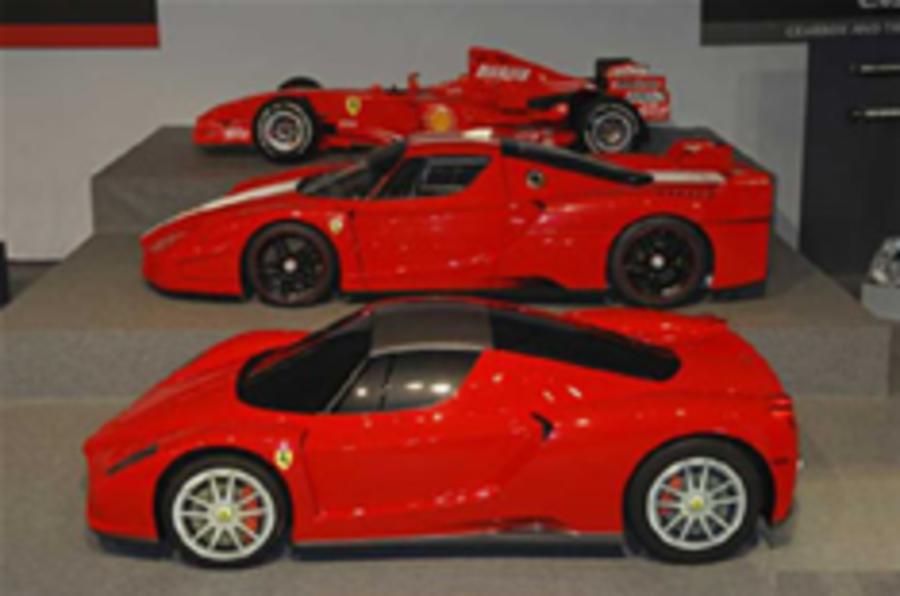On the eve of its 60th anniversary celebrations, Ferrari has given us a glimpse of its future at a special technology conference held at Fiorano.We're not about to get electric Ferraris, but regenerative braking, advanced turbocharged engines, massive weight reductions and biofuels are all on the cards for the famous Italian brand."The world is changing, and Ferrari is changing too," said a spokesman. The aim is to lose no performance, but to make lighter, more efficient cars.Ferrari displayed its planned technological advances in a special 1000kg Enzo-based car called the FXX Millechili. It's 365kg lighter than the production car. Ferrari says its plan is to reduce the weight of every car it makes by around 300kg over their predecessors.Ferrari reckons that had the Enzo weighed 1000kg its 650bhp would have been as effective as 800bhp.Lighter cars will require less power, and also therefore smaller brakes and lighter suspension components. Handling is also likely to be improved.The 599 GTB, says Ferrari, is the last car it will build using "late 1990s technology" in the shape of a chassis that's a mix of extruded and bonded aluminium. Future cars will have a monocoque chassis, in what was dubbed "a major rethink" of the way Ferraris are built.Engines will be downsized, with smaller capacities, direct injection and turbochargers all playing a part. Future Ferraris will also have the ability to run on E80 bioethanol fuel. The plan is to reduce average CO2 emissions across the range from 400g/km to 250.Transmissions will be smaller and lighter, not least because they will not need to cope with quite as much power. Ferrari also wants to harness regenerative braking power; but unlike in current cars this won't be used to charge the batteries or work in place of the alternator. Instead, it would power a small motor attached to the transmission, with the aim of keeping it spinning, enabling smoother gearchanges.Aerodynamics will also move on. Ferrari is currently working with Imperial College London on an advanced active aerodynamics system that involves using air pumps to push air over and under the car. This smoothes airflow and cuts drag.All of these changes are expected to happen over the next decade, so expect the Ferrari of 2017 to be a very different beast to today's machines.Finally, Ferrari hinted that a replacement for what it dubbed "the collector's car", the Enzo, would be brought to market in 2010. Expect it to be lighter, faster and even more dramatic.After 60 years, it seems that Ferrari is following the advice of Lotus founder Colin Chapman, and adding lightness wherever it can.
…
Not Registered for Autocar Business, Create an account
Forgotten your password?
Reset Password
Post a Comment
main menu
Close
Currently reading: The Ferrari of the future
The Ferrari of the future
Lighter cars, turbocharged engines and regenerative braking
used Ferrari cars for sale
2012
£66,980
34,500miles
Petrol
Automatic
2
2010
£69,000
20,594miles
Petrol
Automatic
2
2011
£69,995
15,500miles
Petrol
Automatic
2
2009
£54,495
47,011miles
Petrol
Automatic
2
2009
£67,950
13,800miles
Petrol
Automatic
2
2011
£60,999
39,937miles
Petrol
Automatic
2
2010
£59,999
42,000miles
Petrol
Automatic
2
2010
£63,995
23,700miles
Petrol
Automatic
2
2013
£60,995
50,000miles
Petrol
Automatic
2
Next
Prev
Powered By


Newsletter
Get all the best car news, reviews and opinions direct to your inbox three times a week. You can unsubscribe via any email we send See our full privacy notice for more detailsMore from Autocar
Top 10s
Latest car reviews
Top manufacturers
We recommend
Autocar is part of Haymarket Automotive, a division of Haymarket Media Group © Haymarket Media Group 2022





Add your comment